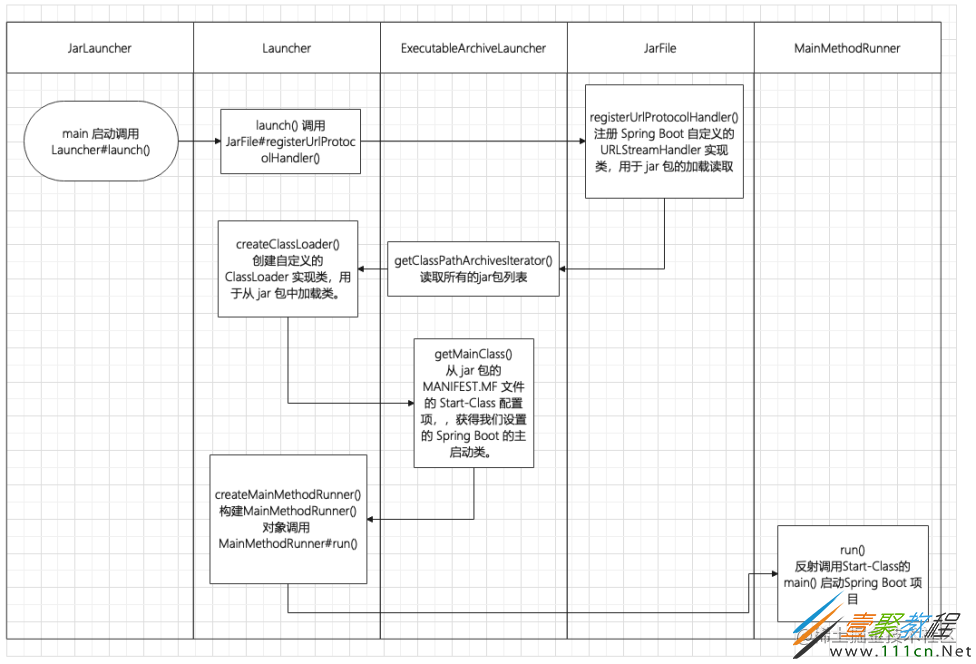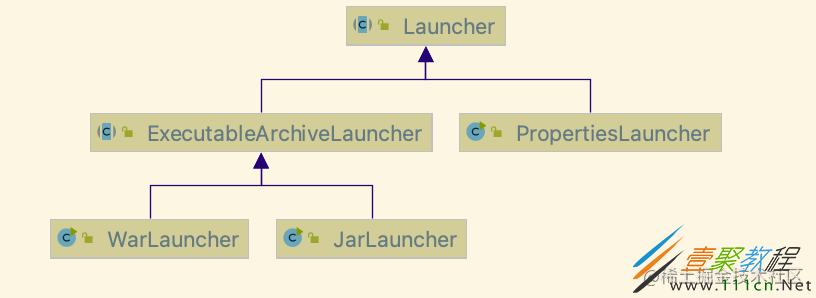SpringBoot为何可以使用Jar包启动代码解析
本篇文章小编给大家分享一下SpringBoot为何可以使用Jar包启动代码解析,文章代码介绍的很详细,小编觉得挺不错的,现在分享给大家供大家参考,有需要的小伙伴们可以来看看。
Spring Boot 打包插件
Spring Boot 提供了一个名叫spring-boot-maven-plugin的 maven 项目打包插件,如下:
org.springframework.boot spring-boot-maven-plugin
可以方便的将 Spring Boot 项目打成 jar 包。 这样我们就不再需要部署 Tomcat 、Jetty等之类的 Web 服务器容器啦。
我们先看一下 Spring Boot 打包后的结构是什么样的,打开 target 目录我们发现有两个jar包:
其中,springboot-0.0.1-SNAPSHOT.jar是通过 Spring Boot 提供的打包插件采用新的格式打成 Fat Jar,包含了所有的依赖;
而springboot-0.0.1-SNAPSHOT.jar.original则是Java原生的打包方式生成的,仅仅只包含了项目本身的内容。
SpringBoot FatJar 的组织结构
我们将 Spring Boot 打的可执行 Jar 展开后的结构如下所示:
BOOT-INF目录:包含了我们的项目代码(classes目录),以及所需要的依赖(lib 目录);
META-INF目录:通过MANIFEST.MF文件提供 Jar包的元数据,声明了 jar 的启动类;
org.springframework.boot.loader:Spring Boot 的加载器代码,实现的 Jar in Jar 加载的魔法源。
我们看到,如果去掉BOOT-INF目录,这将是一个非常普通且标准的Jar包,包括元信息以及可执行的代码部分,其/META-INF/MAINFEST.MF指定了Jar包的启动元信息,org.springframework.boot.loader执行对应的逻辑操作。
MAINFEST.MF 元信息
元信息内容如下所示:
Manifest-Version: 1.0 Spring-Boot-Classpath-Index: BOOT-INF/classpath.idx Implementation-Title: springboot Implementation-Version: 0.0.1-SNAPSHOT Spring-Boot-Layers-Index: BOOT-INF/layers.idx Start-Class: com.listenvision.SpringbootApplication Spring-Boot-Classes: BOOT-INF/classes/ Spring-Boot-Lib: BOOT-INF/lib/ Build-Jdk-Spec: 1.8 Spring-Boot-Version: 2.5.6 Created-By: Maven Jar Plugin 3.2.0 Main-Class: org.springframework.boot.loader.JarLauncher
它相当于一个 Properties 配置文件,每一行都是一个配置项目。重点来看看两个配置项:
Main-Class 配置项:Java 规定的 jar 包的启动类,这里设置为 spring-boot-loader 项目的 JarLauncher 类,进行 Spring Boot 应用的启动。
Start-Class 配置项:Spring Boot 规定的主启动类,这里设置为我们定义的 Application 类。
Spring-Boot-Classes 配置项:指定加载应用类的入口。
Spring-Boot-Lib 配置项: 指定加载应用依赖的库。
启动原理
Spring Boot 的启动原理如下图所示:
源码分析
JarLauncher
JarLauncher 类是针对 Spring Boot jar 包的启动类, 完整的类图如下所示:
其中的 WarLauncher 类,是针对 Spring Boot war 包的启动类。 启动类org.springframework.boot.loader.JarLauncher并非为项目中引入类,而是spring-boot-maven-plugin插件 repackage 追加进去的。
接下来我们先来看一下 JarLauncher 的源码,比较简单,如下图所示:
public class JarLauncher extends ExecutableArchiveLauncher {
private static final String DEFAULT_CLASSPATH_INDEX_LOCATION = "BOOT-INF/classpath.idx";
static final EntryFilter NESTED_ARCHIVE_ENTRY_FILTER = (entry) -> {
if (entry.isDirectory()) {
return entry.getName().equals("BOOT-INF/classes/");
}
return entry.getName().startsWith("BOOT-INF/lib/");
};
public JarLauncher() {
}
protected JarLauncher(Archive archive) {
super(archive);
}
@Override
protected ClassPathIndexFile getClassPathIndex(Archive archive) throws IOException {
// Only needed for exploded archives, regular ones already have a defined order
if (archive instanceof ExplodedArchive) {
String location = getClassPathIndexFileLocation(archive);
return ClassPathIndexFile.loadIfPossible(archive.getUrl(), location);
}
return super.getClassPathIndex(archive);
}
private String getClassPathIndexFileLocation(Archive archive) throws IOException {
Manifest manifest = archive.getManifest();
Attributes attributes = (manifest != null) ? manifest.getMainAttributes() : null;
String location = (attributes != null) ? attributes.getValue(BOOT_CLASSPATH_INDEX_ATTRIBUTE) : null;
return (location != null) ? location : DEFAULT_CLASSPATH_INDEX_LOCATION;
}
@Override
protected boolean isPostProcessingClassPathArchives() {
return false;
}
@Override
protected boolean isSearchCandidate(Archive.Entry entry) {
return entry.getName().startsWith("BOOT-INF/");
}
@Override
protected boolean isNestedArchive(Archive.Entry entry) {
return NESTED_ARCHIVE_ENTRY_FILTER.matches(entry);
}
public static void main(String[] args) throws Exception {
//调用基类 Launcher 定义的 launch 方法
new JarLauncher().launch(args);
}
}
主要看它的 main 方法,调用的是基类 Launcher 定义的 launch 方法,而 Launcher 是ExecutableArchiveLauncher的父类。下面我们来看看Launcher基类源码:
Launcher
public abstract class Launcher {
private static final String JAR_MODE_LAUNCHER = "org.springframework.boot.loader.jarmode.JarModeLauncher";
protected void launch(String[] args) throws Exception {
if (!isExploded()) {
JarFile.registerUrlProtocolHandler();
}
ClassLoader classLoader = createClassLoader(getClassPathArchivesIterator());
String jarMode = System.getProperty("jarmode");
String launchClass = (jarMode != null && !jarMode.isEmpty()) ? JAR_MODE_LAUNCHER : getMainClass();
launch(args, launchClass, classLoader);
}
@Deprecated
protected ClassLoader createClassLoader(List archives) throws Exception {
return createClassLoader(archives.iterator());
}
protected ClassLoader createClassLoader(Iterator archives) throws Exception {
List urls = new ArrayList<>(50);
while (archives.hasNext()) {
urls.add(archives.next().getUrl());
}
return createClassLoader(urls.toArray(new URL[0]));
}
protected ClassLoader createClassLoader(URL[] urls) throws Exception {
return new LaunchedURLClassLoader(isExploded(), getArchive(), urls, getClass().getClassLoader());
}
protected void launch(String[] args, String launchClass, ClassLoader classLoader) throws Exception {
Thread.currentThread().setContextClassLoader(classLoader);
createMainMethodRunner(launchClass, args, classLoader).run();
}
protected MainMethodRunner createMainMethodRunner(String mainClass, String[] args, ClassLoader classLoader) {
return new MainMethodRunner(mainClass, args);
}
protected abstract String getMainClass() throws Exception;
protected Iterator getClassPathArchivesIterator() throws Exception {
return getClassPathArchives().iterator();
}
@Deprecated
protected List getClassPathArchives() throws Exception {
throw new IllegalStateException("Unexpected call to getClassPathArchives()");
}
protected final Archive createArchive() throws Exception {
ProtectionDomain protectionDomain = getClass().getProtectionDomain();
CodeSource codeSource = protectionDomain.getCodeSource();
URI location = (codeSource != null) ? codeSource.getLocation().toURI() : null;
String path = (location != null) ? location.getSchemeSpecificPart() : null;
if (path == null) {
throw new IllegalStateException("Unable to determine code source archive");
}
File root = new File(path);
if (!root.exists()) {
throw new IllegalStateException("Unable to determine code source archive from " + root);
}
return (root.isDirectory() ? new ExplodedArchive(root) : new JarFileArchive(root));
}
protected boolean isExploded() {
return false;
}
protected Archive getArchive() {
return null;
}
}
launch 方法会首先创建类加载器,而后判断是否 jar 是否在MANIFEST.MF文件中设置了jarmode属性。
如果没有设置,launchClass 的值就来自getMainClass()返回,该方法由PropertiesLauncher子类实现,返回 MANIFEST.MF 中配置的Start-Class属性值。
调用createMainMethodRunner方法,构建一个MainMethodRunner对象并调用其 run 方法。
PropertiesLauncher
@Override
protected String getMainClass() throws Exception {
//加载 jar包 target目录下的 MANIFEST.MF 文件中 Start-Class配置,找到springboot的启动类
String mainClass = getProperty(MAIN, "Start-Class");
if (mainClass == null) {
throw new IllegalStateException("No '" + MAIN + "' or 'Start-Class' specified");
}
return mainClass;
}
MainMethodRunner
目标类main方法的执行器,此时的 mainClassName 被赋值为 MANIFEST.MF 中配置的 Start-Class 属性值,也就是com.listenvision.SpringbootApplication,之后便是通过反射执行 SpringbootApplication 的 main 方法,从而达到启动 Spring Boot 的效果。
public class MainMethodRunner {
private final String mainClassName;
private final String[] args;
public MainMethodRunner(String mainClass, String[] args) {
this.mainClassName = mainClass;
this.args = (args != null) ? args.clone() : null;
}
public void run() throws Exception {
Class mainClass = Class.forName(this.mainClassName, false, Thread.currentThread().getContextClassLoader());
Method mainMethod = mainClass.getDeclaredMethod("main", String[].class);
mainMethod.setAccessible(true);
mainMethod.invoke(null, new Object[] { this.args });
}
} 相关文章
精彩推荐
-
 下载
下载模拟极限越野
模拟经营 模拟极限越野模拟极限越野开着大巴在各种奇葩路况里送乘客。山路弯道多得让人
-
 下载
下载模拟火车
模拟经营 模拟火车模拟火车让你当回真正的火车司机,得先学会看信号灯、操作控制杆
-
 下载
下载可口的披萨美味的披萨
模拟经营 可口的披萨美味的披萨可口的披萨美味的披萨带您体验经营一家披萨店的乐趣。游戏画风温
-
 下载
下载定制虚拟偶像最新版
模拟经营 定制虚拟偶像最新版定制虚拟偶像最新版是一款超级经典有趣的日本模拟装扮类型的手游
-
 下载
下载病娇模拟器手机版正版(yandere simulator)
模拟经营 病娇模拟器手机版正版(yandere simulator)病娇模拟器最新版手游是一款萌妹二次元模拟游戏,玩家在游戏中可



















